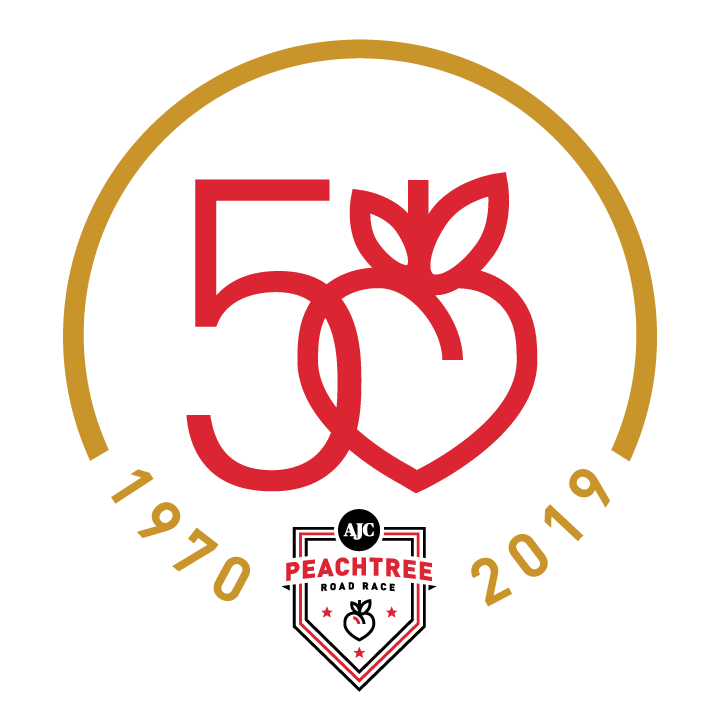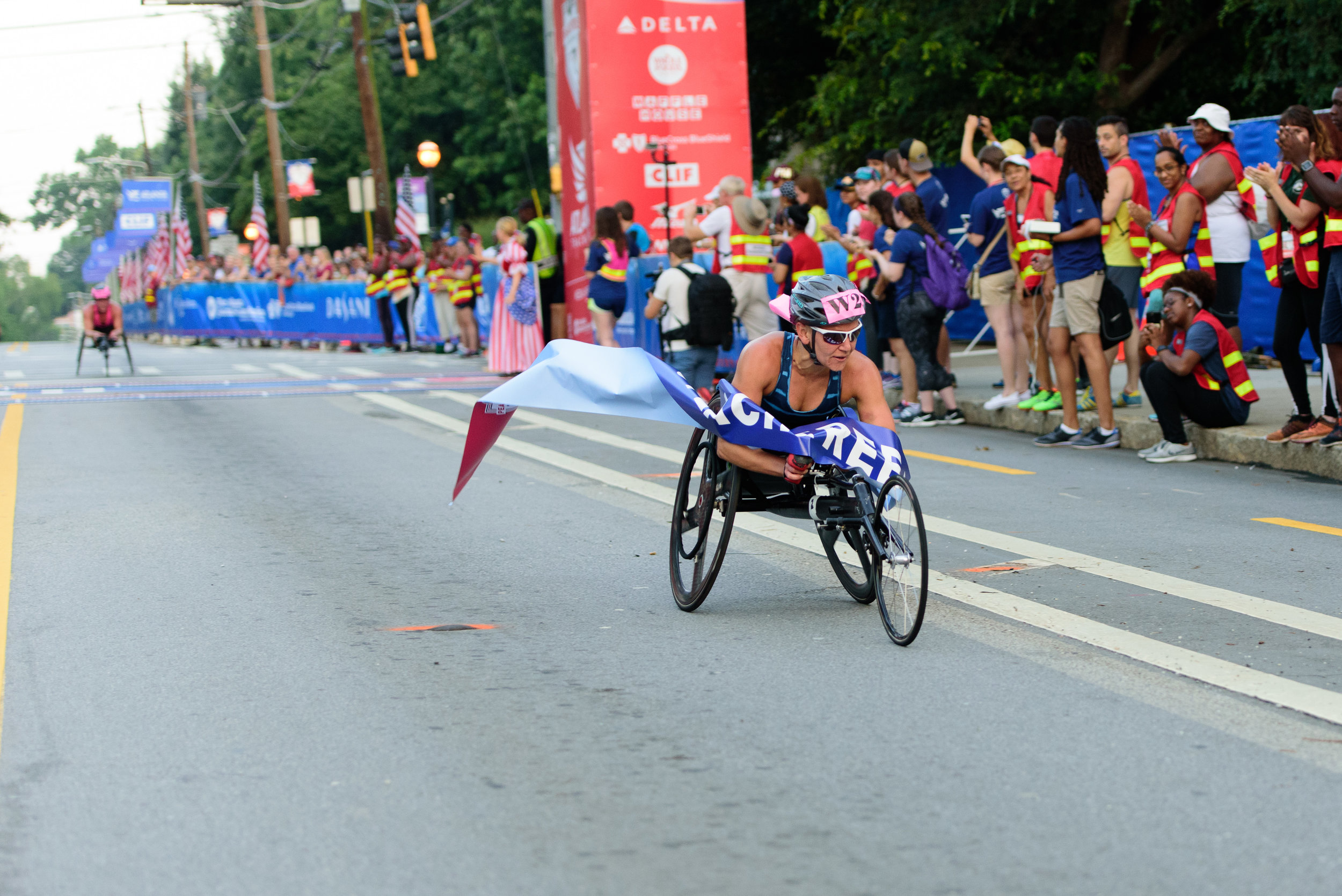The Wheelchair Division at the Peachtree

Jeremy Maddox sat outside the Shepherd Center on July 4, 1998, not quite sure of what he was about to see.
“All of a sudden” he recalled, “you feel this energy start to build.”
Sirens broke the early-morning quiet. Cheers went up in the unseen distance. Then came “an amazing show. You see these racers who are absolutely flying up this hill, like it’s not even there.”
The hill was Cardiac. The event was the AJC Peachtree Road Race. The racers were leading the Shepherd Center Wheelchair Division.
And Maddox, just 16 years old and newly paralyzed from the waist down after a motocross accident, saw his future. As the athletes – maybe 14-time Paralympic gold medalist Franz Nietlispach, who won that year, or Krige Schabort, a six-time Paralympian who finished second – climbed that hill just past halfway into the race, Maddox thought: “Man, I want to do that.”
The Shepherd Center was founded in 1975 after another young man’s life was upended. Two years earlier, James Shepherd, then 22, was slammed to the ocean floor while bodysurfing off a beach in Rio de Janeiro, leaving him paralyzed from the neck down.
After five weeks in a Brazilian hospital, he was flown back home to an Atlanta hospital, his survival still in doubt. When his family learned of a rehabilitation facility in Colorado, his father flew out to visit and the decision was made: James would transfer.
“It was like you flipped a light switch: It was night and day,” recalled his father, Harold, in a Shepherd Center video. Six months later, James – with the aid of a crutch and leg brace – walked out of the facility.
After returning to Atlanta, Harold and his wife, Alana, dedicated themselves to launching a rehab center closer to home. Starting with six beds in an Atlanta hospital in August 1975, Shepherd Center opened its own facility in 1982 and is now among the most renowned in the world.
In addition to its 152 beds and dozens of other programs, Shepherd Center sponsors 11 sports teams, the largest such program in North America. Among them is the Shepherd Spinners, now coached by Schabort. Most of the 16 athletes in the Spinners are expected to compete in the 2019 Peachtree.
When Schabort, now 55, moved to the Atlanta area from his native South Africa in 1997, he began training with the Spinners. He has 11 top-3 finishes since 1998, including five victories in the open division. Last year, he won the masters division.
“I always try to spot someone I know – not really see, but listen for someone cheering,” said Schabort, of passing the Shepherd Center crowd, which usually numbers 150-200 and hands sweatbands out to runners. “But very seldom do I hear my name because the crowd is so loud. It’s thrilling to go up there. It’s the hardest part of the race, but almost the most rewarding. There are people in hospital beds. It’s amazing what they do to get guys out there to see what’s possible.”
It’s a sight that amazes runners, too.
“You think you’re having difficulty getting up the hill,” said Jamie Shepherd, COO of the Shepherd Center and grandson of Harold. “Then you see the patients and know the battle they face on a daily basis, and you get up that hill pretty easily.”
Wheelchair athletes began competing in the Peachtree in 1978, as part of the overall field of runners – a photo in “25 Years of the Peachtree Road Race” near the start of the race shows pioneer Bob Hall, in what appears to be a standard everyday chair, carving out a spot for himself along the right-hand side of the road amid an incoming tide of runners.
Because of the perceived safety hazard, wheelchairs were banned in 1980 and 1981. “In a nutshell, they’re afraid we might be in the way,” said wheelchair athlete and former Shepherd patient Terry Lee at the time.
“We were as worried as the track club was,” recalled James Shepherd, now chairman of the Board of Directors, who said that even though Shepherd wasn’t officially involved at the time, “we wanted to help figure out how we could make it a safe venture.”
An agreement was reached, and in 1982 the race again accepted wheelchairs – and gave them their own start. That first year, the Georgia Wheelchair Association sponsored a field of 11 athletes. The legendary George Murray won in 27:38; there were no women entrants. The next year, Candace Cable Brooks became the first female winner, in 31:34.
In 1984, the Shepherd Center took over sponsorship. Since then, Murray and Brooks have been joined in the record books by nearly all of the top wheelchair athletes in the world, among them 10-time Boston Marathon winner Ernst van Dyk (the 2010 Peachtree winner) of South Africa; 13-time Paralympic medalist Kurt Fearnley (a 3-time Peachtree winner) of Australia; eight-time Boston Marathon winner Jean Driscoll (5-time Peachtree winner); eight-time Paralympic medalist Edith Hunkeler (four-time Peachtree winner and course record holder) of Switzerland; and Tatyana McFadden, 17-time Paralympic medalist and the winningest athlete in any division in Peachtree history, with seven victories.
Last year, the Shepherd Center Wheelchair Division was won by Americans Daniel Romanchuk, who defended his title with a time of 18:40, and Susannah Scaroni in 22:50. Each won $5,000, part of a $42,000 total prize purse.
This year, to mark the 50th Running of the AJC Peachtree Road Race, winners of all four divisions will earn a $50,000 bonus if they break the course record. For the wheelchair athletes, it offers the chance for the biggest payday in the history of the sport.
“At first I wondered if there was a missing decimal point,” said Romanchuk, whose winning time last year was just two seconds shy of Saul Mendoza’s 2004 course record. “This is a historic event in wheelchair racing.”
Unlike many champions, Scaroni has been competing in the Peachtree for more than half her life – now 28, she first raced here when she was just 11.
“Peachtree is such an iconic race for people in wheelchairs, because there’s so much support and especially because of Shepherd,” said the two-time Paralympian, who grew up near Spokane, Washington. “As a kid, I was fortunate enough to be in a junior sports team program where my coach understood the importance of us getting exposure to pro wheelchair racers.”
Paralyzed at the age of 5 after a car accident, Scaroni said she finds it especially meaningful to share a post-race brunch with patients at Shepherd after the awards ceremony.
“I went through rehab as well,” she said. “To see someone else excelling at life, doing something they love … I love to be able to share that. A lot of the reasons I’m an adult wheelchair racer is because of Peachtree.”
Last year, Peachtree featured seven divisions for wheelchair athletes: open men and women, masters, grandmasters, open quads, T1 quads (a classification for athletes with less upper-arm strength), push assist and juniors, with a total of 50 athletes competing the race. The field may be the largest in the country for a non-marathon.
“It’s so important for our patients to see this, to see the possibilities, and then take this back to their own communities,” said Becky Washburn, manager of Shepherd’s wellness program and its wheelchair race coordinator.
Jeremy Maddox not only saw the possibilities, he lived them. Six years after witnessing that first post-accident race from the sidewalk in front of Shepherd, Maddox competed in the Peachtree for the first time. One sport led to another, and in 2013 he was part of a 12-person U.S. team that won a gold medal in the World Disabled Waterski Championships.
Maddox has raced the Peachtree 10 times or so over the years, and plans to make the trip from his home in Rawton, near Athens, to do so again this year.
He’s still on the Shepherd Spinners team, and hoping for a Top 10 finish.








